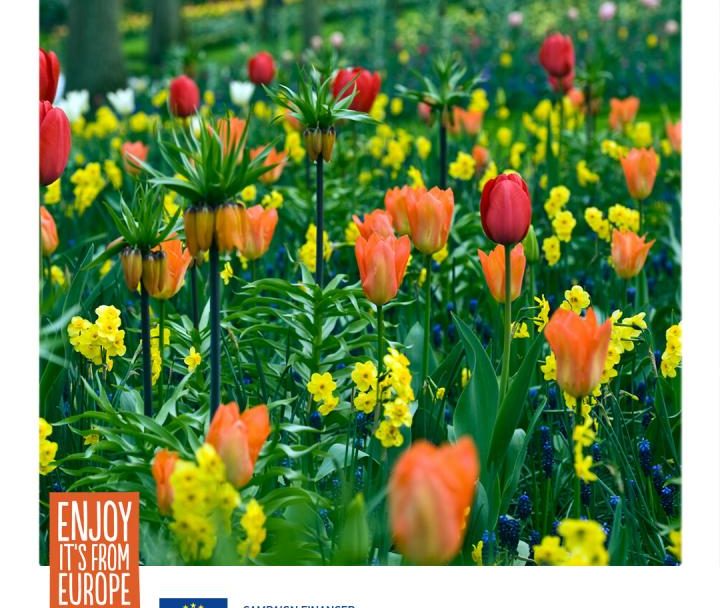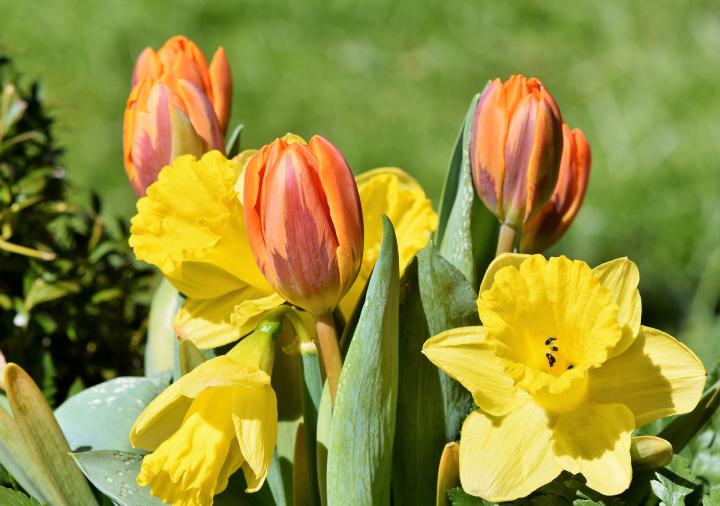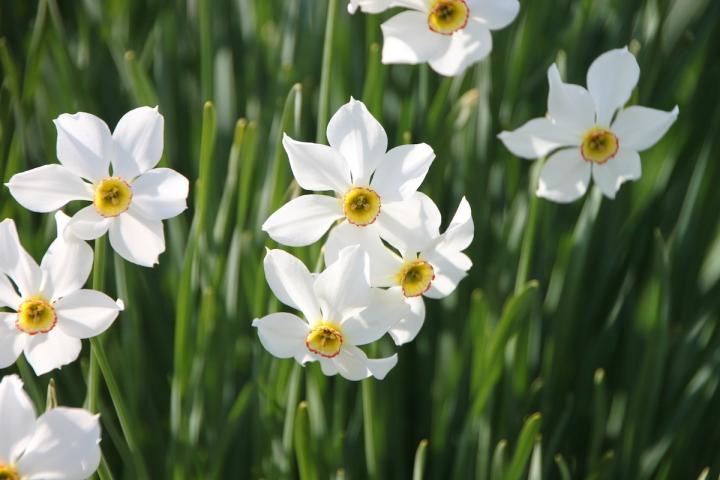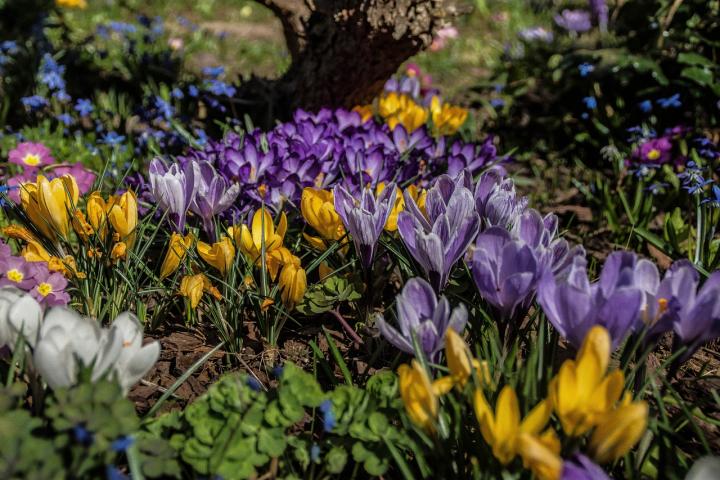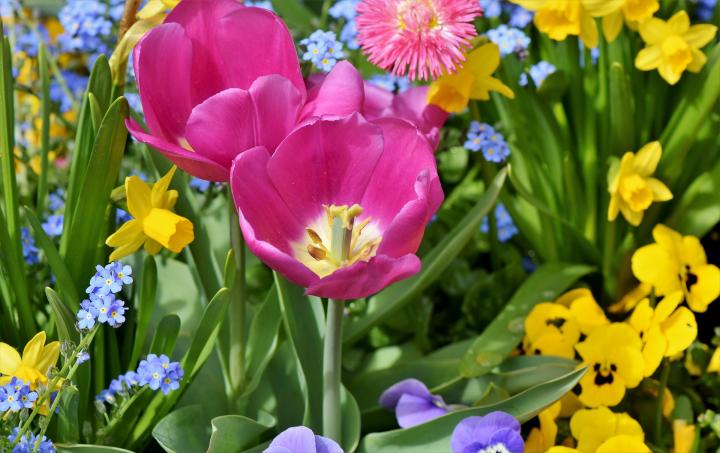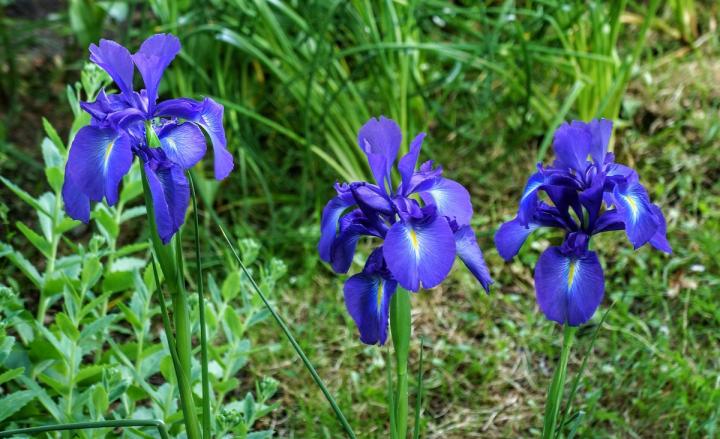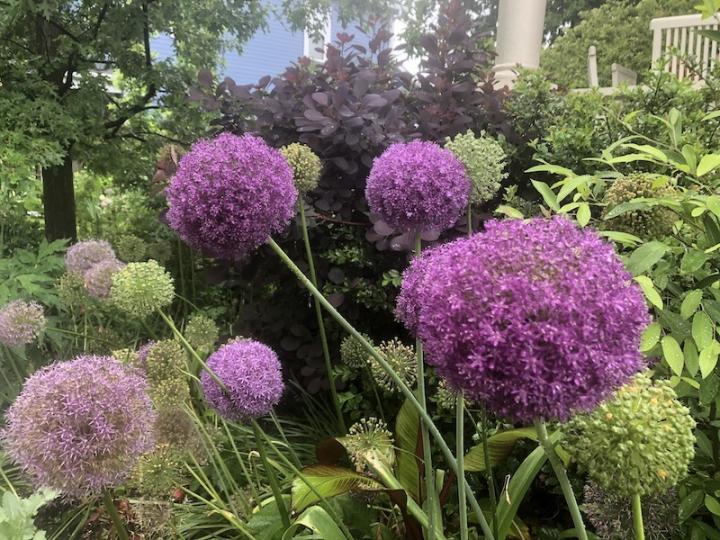If you haven’t planted fall bulbs, it’s the perfect time! We’ve listed the best, most reliable bulbs for a glorious springtime display—PLUS, which bulbs are deer-resistant. We also have a wonderful chart that shows which flowers bloom early, mid-, and late spring for color all season!
WHAT ARE FALL BULBS?
Fall bulbs don’t flower in the fall. They’re planted in the fall to then bloom gloriously in the springtime! Think crocus, snowdrops, daffodils, tulips, and hyacinth, among others!
- This is in contrast to summer-flowering bulbs such as dahlias, elephant ear, caladium, gladiolus, and cannas, which are planted in the spring.
Why do we plant spring-flowering bulbs in the fall? These spring beauties are what we call “dormant perennial.” They need the cool, moist autumn soil to awaken them from their dormancy so they can begin growing roots in preparation for the spring show.
If you’re a beginner gardener, bulbs are so easy to pop in the ground (and spark your interest in gardening)! They’re foolproof to plant and really lift the spirits, not to mention feed the early pollinators such as the drowsy queen bumblebees.
WHEN TO PLANT FALL BULBS
The best time to plant fall bulbs is when soils are below 60°F in the late fall or about 6 weeks before a hard frost is expected. Consult our Frost Dates Calculator for fall frost dates.
This is usually during September and October in the North. (Halloween is a good deadline to set.) In the South, bulbs are generally planted a little later—in October and November. (Tulips are one exception—you can plant tulips as late in winter as you can get them into the soil.)
In the warmest parts of the South, you may need to pre-cool some bulbs. Most fall bulbs require a 12 to 16 week cold period in ventilated packages in the bottom of your refrigerator at 40° to 50°F before planting. Check with your bulb supplier to determine whether the bulbs you purchase have been pre-cooled or whether you may need to give them a cold treatment.
Also, in warmer climates, note that some bulbs will only bloom once and then they’re done for the season. For example, you will have to plant tulip bulbs again each year. Still, they are a beautiful sight to behold and well worth the effort! Other fall bulbs, such as daffodils, will act as perennials and come up year after year.
OUR FALL BULB PLANTING CHART
See our chart below for a summary of each bulbs’ preferences—in terms of soil type, soil depth and spacing, and other details. Below this chart, we’ll add some additional information to each bulb choice.
Click here for a printable chart.
| Common Name | Hardiness
Zone |
Soil | Sun/Shade | Spacing (in) | Depth (in) | Blooming Season | Height (in) |
|---|---|---|---|---|---|---|---|
| Bluebell | 4–9 | Well–drained/ fertile |
Full sun/ Partial Shade |
4 | 3-4 | Spring | 8–20 |
| Christmas Rose/ Hellebore |
4–8 | Neutral—alkaline | Full sun/ Partial Shade |
18 | 1-2 | Spring | 12 |
| Crocus | 3–8 | Well–drained/ moist/fertile |
Full sun/ Partial Shade |
4 | 3 | Early Spring | 5 |
| Daffodil | 3–10 | Well–drained/ moist/fertile |
Full sun/ Partial Shade |
6 | 6 | Early Spring | 14–24 |
| Fritillary | 3–9 | Well–drained/ sandy |
Full sun/ Partial Shade |
3 | 3 | Midspring | 6–30 |
| Glory of the snow | 3–9 | Well–drained/ moist |
Full sun/ Partial Shade |
3 | 3 | Spring | 4–10 |
| Grape hyacinth | 4–10 | Well–drained/ moist/fertile |
Full sun/ Partial Shade |
3–4 | 2–3 | Late winter to spring |
6–12 |
| Iris, bearded | 3–9 | Well–drained | Full sun/ Partial Shade |
4 | 4 | Early spring to early summer |
3–48 |
| Iris, Siberian | 4–9 | Well–drained | Full sun/ Partial Shade |
4 | 4 | Early spring to midsummer |
18–48 |
| Ornamental onion | 3–10 | Well–drained/ moist/fertile |
Full sun | 12 | 3–4 | Late spring to early summer |
6–60 |
| Snowdrop | 3–9 | Well–drained/ moist/fertile |
Full sun/ Partial Shade |
3 | 3 | Spring | 6–12 |
| Snowflake | 5–9 | Well–drained/ moist/sandy |
Full sun/ Partial Shade |
4 | 4 | Spring | 6–18 |
| Spring starflower | 6–9 | Well–drained loam | Full sun/ Partial Shade |
3–6 | 3 | Spring | 4–6 |
| Star of Bethlehem | 5–10 | Well–drained/ moist |
Full sun/ Partial Shade |
2–5 | 4 | Spring to summer | 6–24 |
| Striped squill | 3–9 | Well–drained | Full sun/ Partial Shade |
6 | 3 | Spring | 4–6 |
| Tulip | 4–8 | Well–drained/ fertile |
Full sun/ Partial Shade |
3–6 | 4–6 | Early to late spring |
8–30 |
| Winter aconite | 4–9 | Well–drained/ moist/fertile |
Full sun/ Partial Shade |
3 | 2–3 | Late winter to spring |
2–4 |
Click here or on the image below to see a larger version of the chart.
CHOOSING BULBS
Generally speaking, higher-quality bulbs are bigger (for their type) and will flower more profusely. Second-rate bulbs don’t germinate as often, have smaller blooms, and often don’t return year after year.
Good bulbs should be fresh and firm, not brittle or rotted or moldy. Also, choose bulbs with intact husks to better fight any disease. When you receive bulbs, plant immediately or store in a cool, dark, dry place at around 60° to 65°F. Temperatures above 70°F. may damage the flower buds.
Do you have voles or squirrels or deer? We would consider the beautiful tulip and the delicate crocus off your list. Or, consider planting your bulbs in a “cage” fashioned with chicken wire. Also, see our article on rodent-proof bulbs.
BUYING BULBS
We suggest you buy bulbs from reputable nursery or local garden centers versus a generic big box store. But also it’s easy to order online; there are many wonderful high-quality online nurseries incuding Dutch suppliers. Another advantage to ordering from a bulb specialist is picking unusual varieties or colors; there are many more choices.
Find out where to find great bulbs at Flowerbulbs.com!
Don’t forget to plant extra for cutting so you can bring some of that spring color indoors.
BEST FLOWER BULBS TO PLANT IN FALL
Below is a list of the most popular and reliable spring-blooming bulbs.
DAFFODILS
* Deer-resistant!
We prefer daffodils over any other bulbs because squirrels, deer, and chipmunks leave them alone! Daffodils come in many colors, not just yellow (pink, orange, white, multi-colored) and their flowers range from trumpets to flat rings to little rose-like cups. They grow best in well-draining soil that has been amended with organic matter or compost. They should be planted at least 6 inches deep and 6 inches apart. They look great in large drifts in groundcover beds or in meadows or planted under hostas.
See the Almanac’s Daffodil Growing Guide.
- Jonquils is the term usually used for a specific type of daffodil known as Narcissus jonquilla. They have tiny blooms and naturalize. They’re one of the first flowers to bloom—and look especially lovely when planted in a grove or field together.
CROCUSES
* Do NOT plant if deer are a problem.
One of the earliest spring flowers, we’re always delighted when crocus appear. These low-to-the-ground bulbs flower in purple, white, yellow, and striped variations, growing about 4 to 6 inches high. Crocus prefer well-drained soil and will grow in partial shade or full Sun. They are perfect for garden borders and even look great when planted in a lawn. They’ll finish their bloom before it’s time to start mowing!
See the Almanac’s Crocus Growing Guide for more planting information.
SNOWDROPS
* Deer-resistant!
Snowdrops (Galanthus) are dainty little little white bells that are just delightful in the late winter and early spring. Deer, voles, and critters avoid these early blooms, so choose snowdrops instead of crocus if you have critter problems.
When blooming en masse, you’ll feel as if you’ve stepped into a fairy tale. We love them when planted in drifts in groundcover beds.
Snowdrops are adaptable, growing well in full or partial shade. They do prefer moist soil, unlike many bulbs, so add leaf molk or compost at planting for plentiful blooms. Plant three inches deep and three inches part.
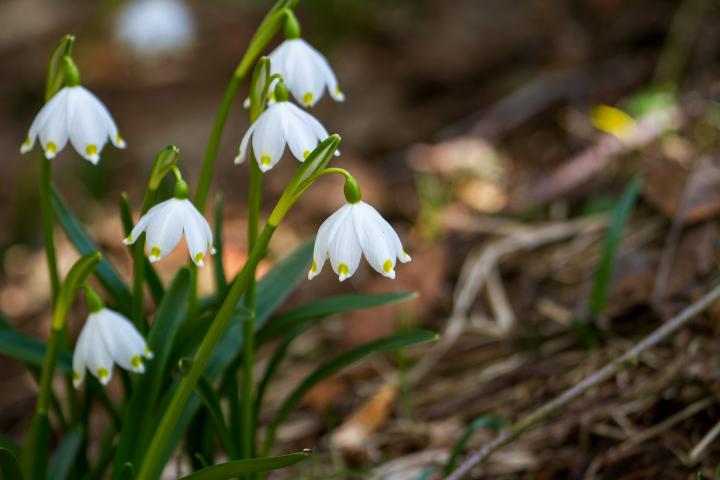
TULIPS
* NOT critter-resistant
One of the best-known spring bulbs, tulips come in a rainbow of colors and variations. They prefer well-drained or sandy soil that is rich in fertlizer. Tulips looks beautiful when planted en masse and bloom after the daffodils. They look great paired with grape hyacinth.
A word of caution: Tulips today are often one-season wonders. Due to hybridization and the fact that squirrels love these bulbs, we tend to treat them as annuals. Expect no more than ¾ of the bulbs will return in their second year and even less in their third year. You’ll just need to plant more tulip bulbs every year (it’s not hard) or protect the bulbs with a nylon mesh.
Some readers claim that planting tulips with daffodil bulbs helps since critters find daffodil bulbs “stinky.” Let us know if this works for you.
See the Almanac’s Tulip Growing Guide.
HYACINTH
These spring beauties bloom around the same time as daffodils and tulips, and have a wonderful fragrance! Small blue clusters of tiny bell-shaped blooms, hyacinth are also good for naturalizing. (They also come in paler pinks, baby blues, yellows, and white). An annual application of compost should provide adequate nutrients. Flower size may decline in subsequent years, so some gardeners treat hyacinths as annuals and plant fresh bulbs each fall.
See the Almanac’s Hyacinth Growing Guide.
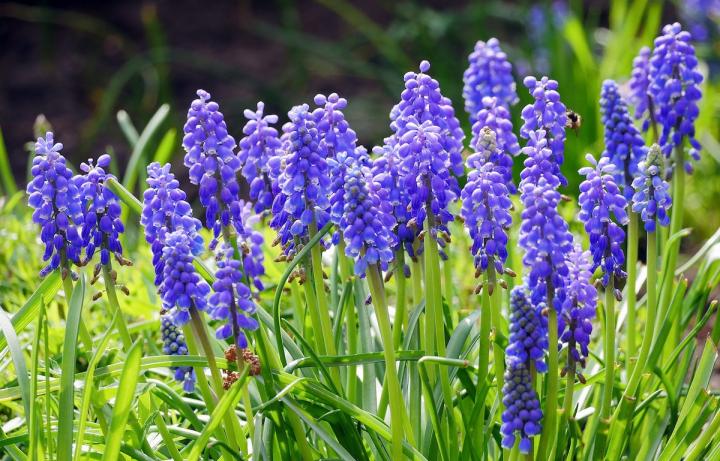
Grape hyacinths (Muscari) are not actually true hyacinths, but their care is very similar.
IRISES
Although not technically bulbs (irises grow from underground structures called rhizomes), irises do best when planted in fall. These tall beauties are hardy, reliable, and easy to grow, attracting butterflies and hummingbirds and making lovely cut flowers. Irises need at least a half a day of sun with EXCELLENT drainage. Planting on a slope or in raised beds helps ensure good drainage. If your soil is heavy, coarse sand or humus may be added to improve drainage.
It’s imperative that the roots of newly planted Iris be well-established before the growing season ends, so we’d plant irises on the earlier end of the range (September in the North and October in the South).
Get more information on how to plant irises.
ALLIUM (ORNAMENTAL ONIONS)
*Deer-resistant!
Looking for a deer- and rodent-resistant bulb? Try growing allium—yes, a member of the onion family!
These purple pom-pom flowers make a dramatic statement in late spring and early summer, especially when when planted en masse. They’re generally a few feet tall and topped with large orb-shaped flowers but there are smaller varieties of addlium, too. The large bulbs do best in loose soil on the sandy side.
Ornamental alliums are great for cutting and bees adore them, too! Learn more about growing allium!
HOW TO PLANT FALL BULBS
Planting bulbs is generally an easy task (unless you’ve ordered hundreds of them), but there are some things that you want to make sure to get right. Here are tips to keep in mind:
- Bulbs need at least part sun throughout the spring. They look beautiful growing beneath trees (before the trees leave out) as planted en mass or in drifts, amidst wildflowers, and mixed witih spring annuals in containers.
- Bulbs need a spot with good drainage or they may rot. Work a few inches of compost or organic matter into the soil before planting for nutrients and drainage, especially if you have heavy clay soils. If your soil is sandy, plant bulbs slightly deeper; in clay soils, slightly shallower.
- Of course, the first tip is to remember to plant bulbs with the point facing up! Examine bulbs carefully before placing them in the planting hole, being sure to set them with the roots facing downward.
- The general rule is to plant bulbs at a depth of three times the width of the bulb, but refer to our chart above for specific planting depths. (See the chart above)
- Consider bloom time for each bulb (early spring, mid-spring, late spring) and plant bulbs with different bloom times so that you have flowers throughout spring!
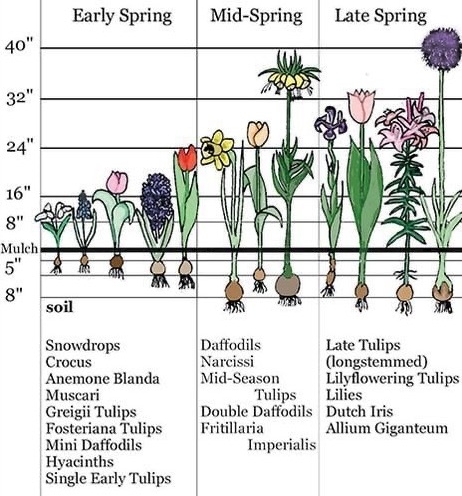
- Place shorter bulbs in the front of beds and borders.
- Plant bulbs generously in case some do not sprout (or are devoured by hungry squirrels). Plant them in random order and spacing for a more natural appearance. Or, if you love groves of daffodils and blanketed landscapes of tulips, be prepared to buy and plant a large quantity of bulbs together!
- You can use a special bulb-planting hand tool to assist you, but if you are planting en masse by the dozens, just use a shovel and make a wide hole for planting many bulbs at once.
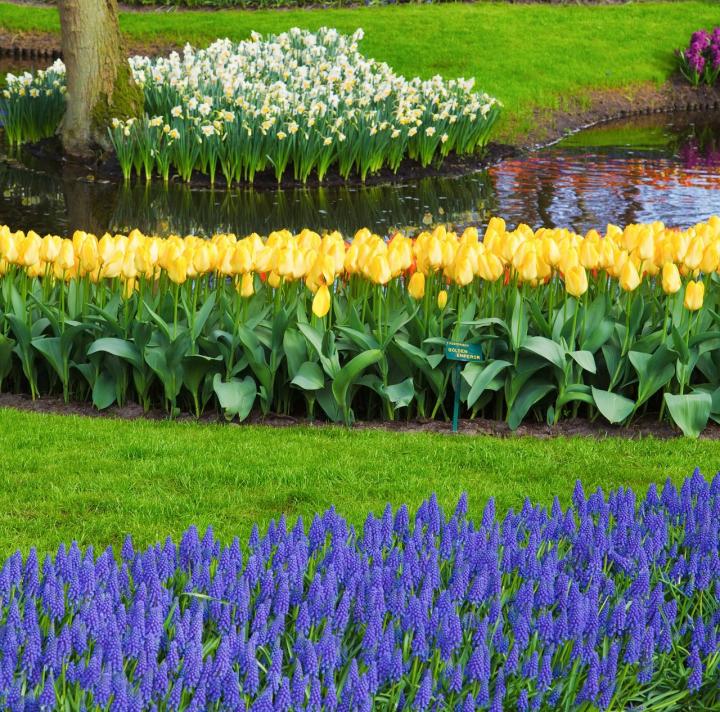
Bulbs look great planted en masse—in a grove, near the mailbox, as swaths of colors in garden beds, and as colorful borders.
- After planting, apply fertilizer that’s fairly low in nitrogen, such as a 9-6-6 formulation.
- Water bulbs deeply after planting—and remember, if your bulb was planted 6” deep into the soil, that water needs to soak in 6” deep to benefit the bulb. This will help settle the soil in the planting bed plus provide needed moisture for the bulbs to start rooting.
- Water again before the ground freezes — the wintertime is when they are developing roots. Don’t overwater which can lead to bulb rot. Gardeners in southern locations can water again in late December or early January if it’s been an unusually dry winter.
- Apply mulch to the planting area to keep the weeds down, hold in moisture, and avoid heaving from wintertime thawing and freezing.
- Note: You will not need to start watering again until the flower buds first appear on the plant in the spring. Once bulbs start growing in the spring, water once a week (if you haven’t had any measurable rain) — this is especially important while they’re flowering. Water with a soaker hose to keep water off the bloom.
Source / The Old Farmer’s Almanac

